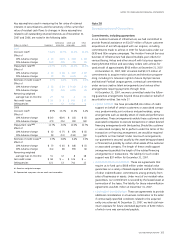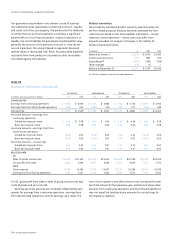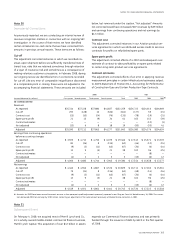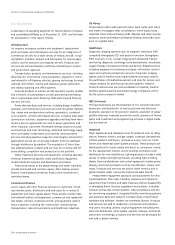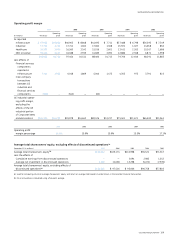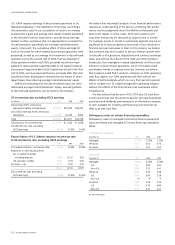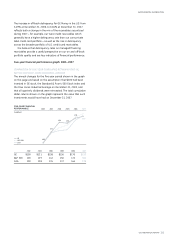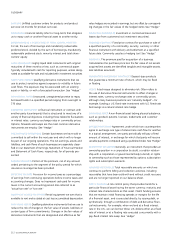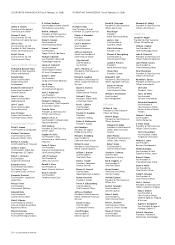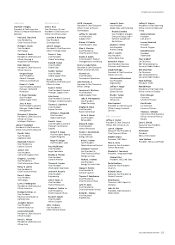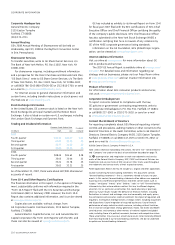GE 2007 Annual Report Download - page 115
Download and view the complete annual report
Please find page 115 of the 2007 GE annual report below. You can navigate through the pages in the report by either clicking on the pages listed below, or by using the keyword search tool below to find specific information within the annual report.ge 2007 annual report 113
MONETIZATION Sale of financial assets to a third party for cash.
For example, we sell certain loans, credit card receivables and
trade receivables to third-party financial buyers, typically providing
at least some credit protection and often agreeing to provide
collection and processing services for a fee. Monetization normally
results in gains on interest-bearing assets and losses on non-interest
bearing assets. See “Securitization” and “Variable Interest Entity.”
OPERATING PROFIT GE earnings from continuing operations
before interest and other financial charges, income taxes and
effects of accounting changes.
OPTION The right, not the obligation, to execute a transaction at
a designated price, generally involving equity interests, interest
rates, currencies or commodities. See “Hedge.”
PREMIUM Rate that is charged under insurance/reinsurance
contracts.
PRODUCT SERVICES For purposes of the financial statement display
of sales and costs of sales in our Statement of Earnings, “goods”
is required by U.S. Securities and Exchange Commission regula-
tions to include all sales of tangible products, and “services”
must include all other sales, including broadcasting and other
services activities. In our Management’s Discussion and Analysis
of Operations we refer to sales of both spare parts (goods) and
related services as sales of “product services,” which is an
important part of our operations.
PRODUCT SERVICES AGREEMENTS Contractual commitments, with
multiple-year terms, to provide specified services for products in
our Infrastructure installed base — for example, monitoring, main-
tenance, overhaul and spare parts for a gas turbine/generator
set installed in a customer’s power plant.
PRODUCTIVITY The rate of increased output for a given level of
input, with both output and input measured in constant currency.
A decline in output for a given level of input is “negative”
productivity.
PROGRESS COLLECTIONS Payments received from customers
as deposits before the associated work is performed or product
is delivered.
REINSURANCE A form of insurance that insurance companies
buy for their own protection.
RETAINED INTEREST A portion of a transferred financial asset
retained by the transferor that provides rights to receive portions
of the cash inflows from that asset.
RETURN ON AVERAGE SHAREOWNERS’ EQUITY Earnings from con-
tinuing operations before accounting changes divided by average
total shareowners’ equity, excluding effects of discontinued oper-
ations (on an annual basis, calculated using a five-point average).
Average total shareowners’ equity, excluding effects of discon-
tinued operations, as of the end of each of the years in the
five-year period ended December 31, 2007, is described in the
Supplemental Information section.
RETURN ON AVERAGE TOTAL CAPITAL INVESTED For GE, earnings
from continuing operations before accounting changes plus the
sum of after-tax interest and other financial charges and minority
interest, divided by the sum of the averages of total shareowners’
equity (excluding effects of discontinued operations), borrowings,
mandatorily redeemable preferred stock and minority interest
(on an annual basis, calculated using a five-point average). Average
total shareowners’ equity, excluding effects of discontinued oper-
ations as of the end of each of the years in the five-year period
ended December 31, 2007, is described in the Supplemental
Information section.
SECURITIZATION A process whereby loans or other receivables are
packaged, underwritten and sold to investors. In a typical trans-
action, assets are sold to a special purpose entity, which purchases
the assets with cash raised through issuance of beneficial interests
(usually debt instruments) to third-party investors. Whether or
not credit risk associated with the securitized assets is retained
by the seller depends on the structure of the securitization. See
“Monetization” and “Variable Interest Entity.”
SUBPRIME For purposes of GE Money related discussion, sub-
prime includes credit card, installment and revolving loans to U.S.
borrowers whose FICO credit score is less than 660. FICO credit
scores are a widely accepted rating of individual consumer credit-
worthiness.
TURNOVER Broadly based on the number of times that working
capital is replaced during a year. Accounts receivable turnover is
total sales divided by the five-point average balance of customer
receivables from sales of goods and services (trade receivables).
Inventory turnover is total sales divided by a five-point average
balance of inventories. See “Working Capital.”
UNEARNED PREMIUMS Portion of the premium received, net of
any amount ceded, that relates to future coverage periods.
UNPAID CLAIMS AND CLAIMS ADJUSTMENT EXPENSES Claims
reserves for events that have occurred, including both reported
and incurred-but-not-reported (IBNR) reserves, and the expenses
of settling such claims.
VARIABLE INTEREST ENTITY Entity defined by Financial Accounting
Standards Board Interpretation 46 (Revised), and that must be
consolidated by its primary beneficiary. A variable interest entity
has one or both of the following characteristics: (1) its equity at
risk is not sufficient to permit the entity to finance its activities
without additional subordinated financial support from other
parties, or (2) as a group, the equity investors lack one or more
of the following characteristics: (a) direct/indirect ability to make
decisions, (b) obligation to absorb expected losses, or (c) right to
receive expected residual returns.
WORKING CAPITAL Sum of receivables from the sales of goods
and services, plus inventories, less trade accounts payables and
progress collections.
glossary


